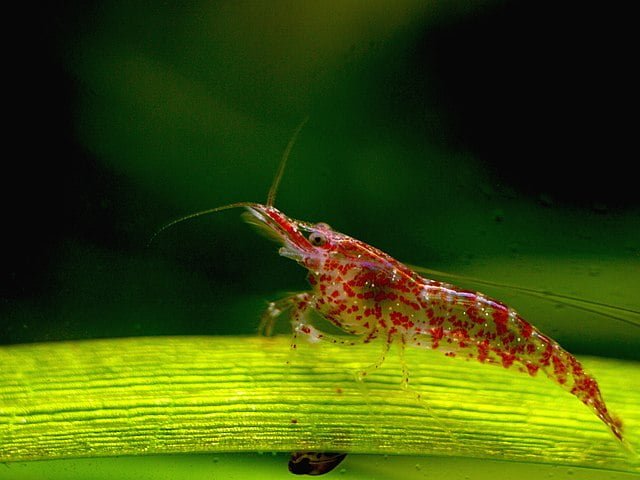
Welcome to the ultimate guide to breeding Platy fish! Whether you’re an experienced aquarist or a novice in the world of fish breeding, this article is your go-to resource for expert tips and tricks on how to successfully raise and breed these vibrant and hardy fish.
With their vibrant colors and playful nature, Platys have become a popular choice for aquarium enthusiasts. But there’s more to them than just their beauty. This comprehensive guide will take you through the entire process of breeding and reproducing Platy fish, from setting up the perfect habitat to ensuring optimal water conditions and nutrition.
On the other hand, beyond their importance in the ornamental fish industry, Platy fish have been used in scientific research as a model for studying evolution, behavioral ecology, sex determination, and in biomedical research to study induced tumors.
In this article, we will delve into the amazing world of the Platy fish. What are the unique characteristics of the Platy fish? How to care for them properly? Additionally, we will explore the different types of Platy fish, their diet, and compatibility with other fish in your aquarium.
Taxonomy of Platy Fish
- 1 Taxonomy of Platy Fish
- 2 Characteristics of Platy Fish
- 3 Habitat of Platy Fish
- 4 Types of PlatyFish
- 5 Platy Fish Feeding
- 6 How to Breed Platy Fish
- 7 Platy Fish Care
- 8 Fish Compatible with Platy Fish
- 9 Diseases Affecting Platies
- 10 Genetic Studies in Xiphophorus maculatus
- 11 Importance of Platy Fish
- 12 Conclusion
- 13 References
- 14 Entradas relacionadas:
Phylum: Chordata
Class: Actinopterygii
Order: Cyprinodontiformes
Family: Poeciliidae
Stay Always Informed
Join our communities to instantly receive the most important news, reports, and analysis from the aquaculture industry.
Genus: Xiphophorus
Scientific Name: Xiphophorus maculatus
Common Names in English: Southern platyfish, common platy, or moonfish
Characteristics of Platy Fish
Platy fish, scientifically known as Xiphophorus maculatus, are a popular choice for aquarium enthusiasts due to their vibrant colors and easy care. These beautiful creatures are known for their colors, shapes, and peaceful behavior, and you can acquire some specimens at prices ranging from $2 to $6, depending on the type.
X. maculatus has different fin shapes and colors and can grow to be 5 to 7 cm, depending on the variety. These fish can live up to 5 years if provided with optimal breeding conditions.
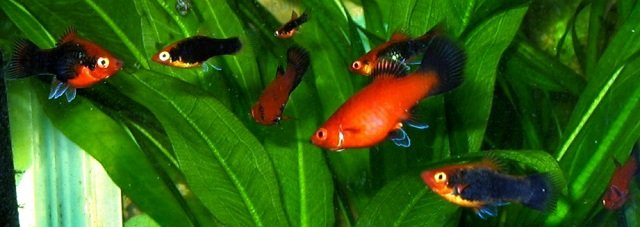
Habitat of Platy Fish
They are native to the freshwater rivers of Mexico, Guatemala, Belize, and Honduras; currently, Platy fish are widely distributed worldwide through the ornamental fish trade.
Platy fish in their natural habitat are found in both lotic and lentic environments such as lakes, lagoons, and rivers. They prefer clear waters with sandy bottoms and aquatic vegetation.
Types of PlatyFish
The world of platys is diverse, and there are several variants of this species, each with unique characteristics. You will learn about the different types of platys, such as the Mickey Mouse Platy, the Tuxedo Platy, the Sunburst Platy, and many more. This section will help you choose the right variant for your aquarium.
The Platy fish (Xiphophorus maculatus) is a popular species in aquariums due to its beauty and ease of care. There are different types or varieties of Platy fish that have been developed over time through selective breeding. Each variety has its own unique characteristics in terms of color and patterns. Below, I present some of the most common varieties of Platy fish:
Common Platy Fish (Xiphophorus maculatus)
This is the wild variety of Platy fish, which generally has softer colors compared to selectively bred varieties. Common platys are usually of more subdued colors, such as gold, orange, or yellow, with spots on their fins.
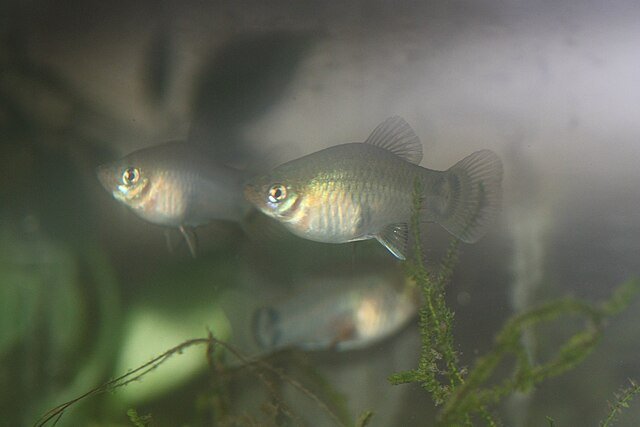
Mickey Mouse Platy Fish
These Platy fish are known for the Mickey Mouse-shaped spots on their caudal fin, resembling the ears of the famous Disney character. They have brightly colored bodies, such as red, orange, and black, making them very eye-catching.
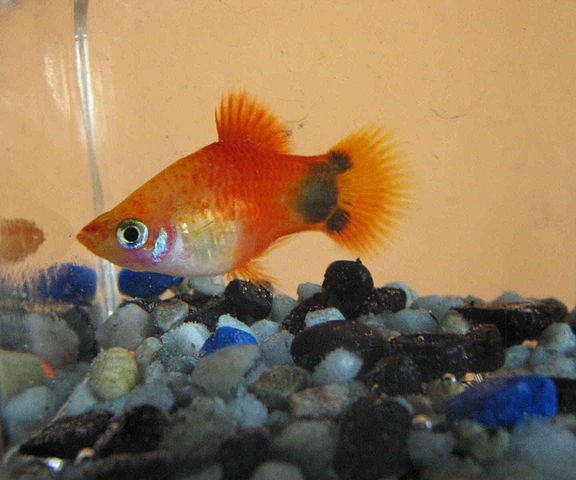
Tuxedo Platy Fish
Tuxedo platys are characterized by their dark-colored bodies, such as black, blue, or brown, with a wide stripe on the back that resembles a tuxedo. This variety creates a strong contrast between the dark body and the colorful fins.

Sunset Platy
Sun platys typically have a bright yellow body that resembles the sun’s glow. They often feature orange or red spots on their fins and body, giving them a warm and sunny appearance.
Coral Platy Fish
These platys are known for their vibrant colors that resemble coral tones. They have orange or pinkish bodies with contrasting fins, giving them a striking appearance.
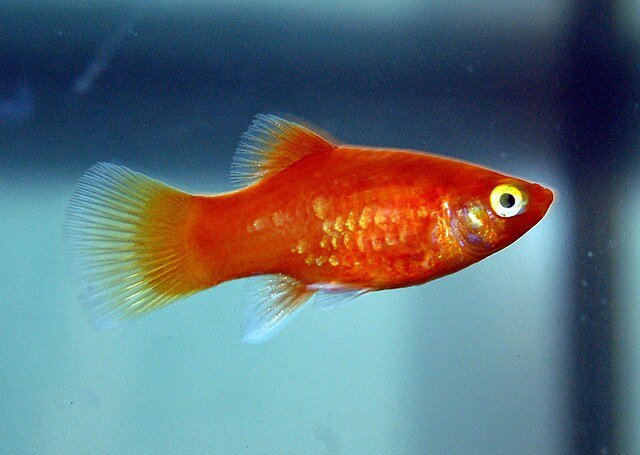
Wagtail Platy Fish
Wagtail platys have a tail with a “wag” or wavy movement, which gives them their name. They can have a variety of colors on their body and fins, but their distinctive feature is the shape of the tail.
Red Wagtail Platy Fish
Similar to wagtail platys, red wagtails have tails with a “wag” shape but with a bright red color, making them particularly striking.

Each variety of platyfish has its own appeal and can be an excellent addition to your aquarium. The choice will depend on your personal preferences and how you want your aquarium to look. Be sure to research the specific needs of each variety to provide proper care.
Platy Fish Feeding
A balanced diet is essential for the health of your Platy fish. Platy fish are omnivorous and consume tubifex worms, small crustaceans, insect larvae, and organic matter.
A common practice is to use food designed for zebrafish or other fish in the Platy fish diet; however, this practice is not recommended as it alters the intestinal microbiome of Platy fish (Soria et al., 2023), putting these fish at risk.
Russo et al. (2022) report that a feeding regimen for Platy fish larvae consisting of commercial flake food, beef liver paste, and live brine shrimp allows for the best growth, higher survival rate, and increased fecundity.
Breeders commonly provide live food to Platy fish. Abdollahi et al. (2019) recommend feeding Platys with Artemia enriched with the microalga Dunaliella salina to enhance mucosal immune responses and improve the carotenoid pigmentation of X. maculatus Platy fish skin.
Vasudhevan et al. (2015) suggest including 50 g/kg of Azolla in the Platy fish diet to enhance coloration and immunological resistance, while Aulia (2020) recommends adding 150 mg/kg of vitamin C to improve growth and feed efficiency in Platy fish.
Furthermore, a common question among aquarists is how much food to provide to their fish. Sapkale et al. (2017) recommend a daily feeding volume of 8% of the body weight of X. maculatus juvenile fish to achieve maximum growth.
Abasali and Mohamad (2011) evaluated the effect of the probiotic Primalac on the reproductive performance of female Platy fish X. maculatus and concluded that the use of 0.09% Primalac in the diet improved fecundity, survival, and larval length.
How to Breed Platy Fish
Xiphophorus maculatus fish reach sexual maturity between three and four months of age, have internal fertilization, and the female spawns within a period that varies between 26 to 29 days (Murakami and Barretto, 2019). Under the right conditions, the female Platy fish can give birth to 20 to 50 fry per month.
If you are new to breeding Platy fish, you may have encountered the difficulty of distinguishing males from females. There is a slight sexual dimorphism; the ventral fin of male Platy fish is more pointed. The anal fin of male fish has evolved into a gonopodium, a stick-shaped organ used for reproduction, while the anal fin of female Platy fish is fan-shaped.
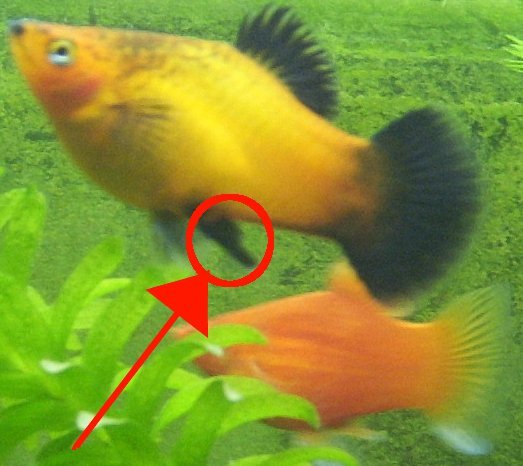
An interesting aspect of Platy fish reproduction is the mate choice made by females. A study conducted by Frankel and Frankel (2017) reported that strong mate choice exhibited by Platy fish females for males of different colors suggests a strategy of negative assortative mating and provides evidence for the maintenance of color polymorphism in natural populations.
In fish, photoperiod is important for initiating or suppressing gonadal maturation and reproduction. In this context, Singh and Zutshi (2020) found that breeding Mickey Mouse Platy fish with a photoperiod of 18 hours of light and 6 hours of darkness significantly increased weight gain, specific growth rate, and gonadosomatic index. It also induced a significant increase in the number of fish with mature embryos and mid-eye embryos in the ovary. Similarly, Shimul and Arfine (2020) highlight that an extended photoperiod can ensure successful reproduction of Platy fish.
On the other hand, Davoodi and Raisi (2019) studied the different male-to-female ratios of Southern Platy fish concerning larval production, and they concluded that a 1:1 ratio is the most efficient.
Breeder Selection
If you want to breed Platy fish, you should select a pair and place them in a 40-liter tank with some plants to help the fry hide and protect themselves from the parents. Once the fry have been born, it is recommended to remove the parents.
Under the right conditions, Platy fish can reproduce every four weeks, so you should monitor the condition of the females’ bodies.
A common question among Platy fish breeders is, “How do you know if a female Platy is pregnant?”
There are physical and behavioral indicators. A pregnant female Platy will have a more swollen abdomen due to the growth of her fry. Additionally, the female exhibits a “gravid spot,” which is a dark coloration on the abdomen near the anal fin; this spot will grow and darken.

Fascinating Aspects of Platy Fish Reproduction
Yang et al. (2012) developed a protocol for the cryopreservation of X. maculatus sperm and artificial insemination of female Platy fish. They succeeded in obtaining fry from cryopreserved sperm in three species of the Xiphophorus genus and identified opportunities to improve female fecundity.
On the other hand, Radkhah et al. (2023b) investigated the effect of salinity on the phenotypic plasticity of X. maculatus Platy fish during early development stages and reported that fry raised in a salinity of 12 ppt had a shallower head, longer-snouted gills, and a shorter caudal peduncle, indicating that salinity plays a significant role in the early stages of life.
In the ornamental fish trade, male Platys are preferred because they are more colorful than female Platys. In this regard, experiments have been conducted to masculinize these fish, but the expected results have not been achieved.
Platy Fish Care
To keep your Platy fish healthy and happy, it is essential to provide them with the right environment. We will discuss the necessary water temperature and quality, as well as feeding and aquarium maintenance.
These fish are highly adaptable and can thrive in a wide range of water conditions, making them a popular choice among aquarists.
In terms of behavior, Platy fish are active swimmers and love to explore their surroundings. They are known for their playful nature and are often seen chasing each other or playing in the currents created by the aquarium filter. Platies are also known for their social behavior and often shoal with other fish in the tank.
Creating the perfect habitat for your Platy fish is essential for their overall health and well-being. Here are the key steps to set up an ideal Platy aquarium:
- Tank Size: Platies are active swimmers and require ample space to move around. A tank of 80 liters or 20 gallons or more is recommended for a small group of Platies. Keep in mind that the more fish you plan to have, the larger the tank should be.
- Substrate: Choose a fine-grained substrate like sand or gravel for your Platy aquarium. This will allow the fish to dig and forage for food naturally. Avoid using materials with sharp edges that could harm the fish. Using a dark-colored substrate is recommended to enhance the coloration of your fish.
- Filtration: A good filtration system is crucial for maintaining optimal water quality in your Platy aquarium. Use a filter that is suitable for the tank’s size and follow the manufacturer’s instructions for installation and maintenance.
- Lighting: Provide appropriate lighting for your Platy aquarium. A combination of natural and artificial light is recommended to mimic their natural habitat. Aim for a photoperiod of around 10 to 12 hours per day. However, Shimul and Arfine (2020) report that an extended photoperiod, even with 24 hours of light, improves growth.
- Decorations: Add some decorations such as plants, rocks, and floating wood to create hiding spots and provide a sense of security for your Platy fish. Live plants not only enhance the tank’s aesthetics but also help maintain water quality. Recommended plants include Java moss, duckweed, and hornwort.
Table 01. Key Water Quality Parameters for Raising Platy Fish (Xiphophorus maculatus).
| Parameter | Range |
| Tank Volume | 40 to 80 liters |
| Water Temperature | 18 – 25 oC |
| Total Water Hardness | 150 mg/L |
| Water Hardness | 9.0 – 19.0 dGH |
| pH | 6.8 – 8.5 |
Fish Compatible with Platy Fish
If you are considering a community tank, it is crucial to understand which fish can peacefully coexist with Platies. We will discuss which species are compatible and which ones should be avoided to prevent conflicts in the tank.
Platies are known for their peaceful nature, making them suitable for community tanks. They can coexist with Molly, Guppies, Corydoras, Cardinal Tetras, Harlequin Rasboras, Otocinclus, Zebra Danios, Neon Tetras, and some freshwater snails.
Diseases Affecting Platies
No aquarium is completely exempt from potential diseases; however, it is essential to note that Platies are resistant to diseases, and there are no infections that specifically target this genus.
However, Platies are susceptible to common diseases like Ich and fin rot. You can find a range of medications for treating these illnesses. Some experts recommend the use of probiotics to reduce the risk of disease occurrence.
Parasites
Liao et al. (2017) reported the co-infection of parasites Eustrongylides ignotus and Centrocestus sp. in Mickey Mouse Platies. They found these parasites in the body cavity of fish that exhibited abdominal distension with convulsions.
On the other hand, Leibowitz et al. (2019) reported a severe outbreak of the parasite Centrocestus formosanus in Platy fish farms in Brazil, with a mortality rate of around 95%. Researchers recommend controlling the density of the snail Melanoides tuberculata because it is the intermediate host of the parasite, in order to reduce outbreaks.
Genetic Studies in Xiphophorus maculatus
Zhang et al. (2011) reported the transcriptome of Xiphophorus maculatus and identified genes expressing sexual differentiation. Schartl et al. (2013) published the sequencing of the Platy fish genome (X. maculatus).
Importance of Platy Fish
Platy fish are used as a model organism in biomedical research; Schartl and Walter (2016) report that Xiphophorus fish are used as models to study cancer.
On the other hand, de Campos et al. (2018) evaluated the ability of Xiphophorus maculatus to reduce the infestation rates of the Aedes aegypti mosquito, known to be a vector of dengue fever. They demonstrated that Platies consume large quantities of mosquito larvae, making them an alternative for disease control programs. Interestingly, the larvivoricity rate of female Platies is higher than that of males (Surendranath et al., 2018).
Conclusion
In summary, the Platy fish is a fantastic choice for those who want to maintain a colorful and low-maintenance aquarium. With its unique features and easy care, they are a perfect choice for beginners and experienced aquarists alike.
If you follow the advice in this article, you will be well-equipped to care for your Platies and enjoy their beauty in your own aquarium. Beyond their beauty, Platy fish are crucial for biomedical research.
References
Abasali, H., & Mohamad, S. (2011). Effect of dietary probiotic level on the reproductive performance of female platy Xiphophorus maculatus. Agricultural Journal, 6(3), 119-123.
Abdollahi, Y., Ahmadifard, N., Agh, N. et al. ß-Carotene-enriched Artemia as a natural carotenoid improved skin pigmentation and enhanced the mucus immune responses of platyfish Xiphophorus maculatus. Aquacult Int 27, 1847–1858 (2019). https://doi.org/10.1007/s10499-019-00437-8
Aulia, R. D. (2020). PENGARUH PENAMBAHAN VITAMIN C PADA PAKAN BUATAN TERHADAP LAJU PERTUMBUHAN DAN KELANGSUNGAN HIDUP BENIH IKAN PLATY SANKE (Xiphophorus maculatus) (Doctoral dissertation, Universitas Djuanda).
Davoodi, F., & Raisi, A. (2019). Effects of adult sex ratio on larvae number and survival of fry in Xiphophorus maculatus (Cyprinodontiformes: Poeciliidae). Journal of Animal Diversity, 1(2), 83-89.
de Campos Júnior, E. O., Silva, C. F., da Silva, C. R., Pereira, B. B., Caixeta, E. S., de Paula, M. B. C., … & de Souza, A. A. (2018). Validation of the species Xiphophorus maculatus for biological control of Aedes aegypty by comparing its larvae-eating potential with Poecilia reticulata. Biological Control, 117, 30-34.
Frankel, T. E., & Frankel, J. S. (2017). Negative Assortative Mating Based on Body Coloration in the Freshwater Platyfish (Poecillidae: Xiphophorus maculatus). Atlas Journal of Biology, 371–375. https://doi.org/10.5147/ajb.v0i0.45
Leibowitz MP, Santos NRV, Tavares GC, Assis GBN, Dorella FA, Figueiredo HCP, Leal CAG (2019) Severe outbreak of Centrocestus formosanus (Trematoda: Heterophyidae) in farm-raised ornamental platies Xiphophorus maculatus. Dis Aquat Org 134:107-111. https://doi.org/10.3354/dao03361
Liao, P. C., Tsai, M. A., Wang, P. C., Ho, Y. S., Pulpipat, T., & Chen, S. C. (2017). Eustrongylides ignotus and Centrocestus sp. co-infection in farmed ornamental Mickey Mouse platy, Xiphophorus maculatus. Bulletin of the European Association of Fish Pathologists, 37(4), 159-168.
Murakami, G., & Barretto, A. (2019). Cultivo e manutenção em laboratório de Xiphophorus maculatus (Platy): dados preliminares. Revista dos Trabalhos de Iniciação Científica da UNICAMP, (27), 1-1.
Radkhah A R, Eagderi S, Abdi A. An overview of the biological characteristics of common platy Xiphophorus maculatus (Teleostei: Poeciliidae) and its cultivation and maintenance in the aquarium. 3 2023; 10 (2) :25-34
Radkhah, A. R., Eagderi, S., Abdi, A., Poorbagher, H., & Rafiee, G. R. (2023b). The effect of salinity on the body shape of platyfish Xiphophorus maculatus (Teleostei: Poeciliidae) during early stages of development using geometric morphometric method. Journal of Animal Research (Iranian Journal of Biology).
Rodrigo, D. C. G., Wijesinghe, R. D. N., & Herath, S. S. (2022). Effects of Total Hardness on Growth Performances, Survival and Feed Utilization Efficiencies of Platy Fish (Xiphophorus maculatus).
Russo, C., Drewery, M., Chang, C. T., Savage, M., Sanchez, L., Varga, Z., … & Lu, Y. (2022). Assessment of Various Standard Fish Diets on Growth and Fecundity of Platyfish (Xiphophorus maculatus) and Medaka (Oryzias latipes). Zebrafish, 19(5), 181-189.
Sapkale, P. H., Patil, S. V., Yadav, S. R., & Gitte, M. J. (2017). Growth performance and feed conversion efficiency of Xiphophorus maculatus (Gunther, 1866) Juveniles at different daily feeding rates. Ecol Environ Conserv, 23(4), 2125-2128.
Schartl, M., Walter, R., Shen, Y. et al. The genome of the platyfish, Xiphophorus maculatus, provides insights into evolutionary adaptation and several complex traits. Nat Genet 45, 567–572 (2013). https://doi.org/10.1038/ng.2604
Schartl, M., & Walter, R. B. (2016). Xiphophorus and medaka cancer models. Cancer and Zebrafish: Mechanisms, Techniques, and Models, 531-552.
Shimul, M., & Arfine, S. (2020). EFFECT OF PHOTOPERIOD ON THE GROWTH PATTERN, BREEDING PERFORMANCE AND COLORATION OF PLATY FISH (XIPHOPHORUS MACULATUS) (Doctoral dissertation, Chattogram Veterinary and Animal Sciences University Chattogram-4225, Bangladesh).
Singh, A., Zutshi, B. Photoperiodic effects on somatic growth and gonadal maturation in Mickey Mouse platy, Xiphophorus maculatus (Gunther, 1866). Fish Physiol Biochem 46, 1483–1495 (2020). https://doi.org/10.1007/s10695-020-00806-8
Soria, E., Russo, C., Carlos-Shanley, C., Drewery, M., Boswell, W., Savage, M., Sanchez, L., Chang, C., Varga, Z. M., Kent, M. L., Sharpton, T. J., & Lu, Y. (2023). Assessment of various standard fish diets on gut microbiome of platyfish Xiphophorus maculatus. Journal of Experimental Zoology Part B: Molecular and Developmental Evolution, 1–7. https://doi.org/10.1002/jez.b.23218
Surendranath, S. V., Nesara, K. M., Rakesh, K., Amogha, K. R., & Naik, M. G. (2018). Evaluation of efficacy of platy Xiphophorus maculatus as larvivorous fish to control mosquito larvae. Indian Journal of Pure & Applied Biosciences, 6, 57-64.
Vasudhevan, I., Devi, P. R., & Asokan, K. (2015). Effect of Azolla pinnata on Coloration and Leucocytes Count in Platy fish, Xiphophorus maculatus.
Yang, H., Savage, M. G., Hazlewood, L., Walter, R. B., & Tiersch, T. R. (2012). Offspring production with cryopreserved sperm from a live-bearing fish Xiphophorus maculatus and implications for female fecundity. Comparative Biochemistry and Physiology Part C: Toxicology & Pharmacology, 155(1), 55-63.
Zhang Z, Wang Y, Wang S, Liu J, Warren W, Mitreva M, et al. (2011) Transcriptome Analysis of Female and Male Xiphophorus maculatus Jp 163 A. PLoS ONE 6(4): e18379. https://doi.org/10.1371/journal.pone.0018379
Editor at the digital magazine AquaHoy. He holds a degree in Aquaculture Biology from the National University of Santa (UNS) and a Master’s degree in Science and Innovation Management from the Polytechnic University of Valencia, with postgraduate diplomas in Business Innovation and Innovation Management. He possesses extensive experience in the aquaculture and fisheries sector, having led the Fisheries Innovation Unit of the National Program for Innovation in Fisheries and Aquaculture (PNIPA). He has served as a senior consultant in technology watch, an innovation project formulator and advisor, and a lecturer at UNS. He is a member of the Peruvian College of Biologists and was recognized by the World Aquaculture Society (WAS) in 2016 for his contribution to aquaculture.

